

Remembering Shirl Greer, and more reader feedback
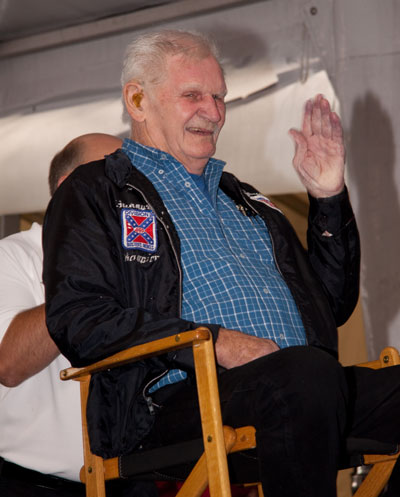 |
Notes about the passing of former NHRA Funny Car champ Shirl Greer last week have dominated my Inbox, and there is some cool stuff worth sharing.
NHRA released a statement, lauding the former champ: "One of the true pioneers of Funny Car racing, Georgia native Shirl Greer will always be remembered as the first to win an NHRA Funny Car world championship title with the modern-day points format. He claimed his place atop the point standings with an incredible resolve and strong work ethic that led him to the title in 1974 over a handful of talented drivers, including Paul Smith, Don Prudhomme, and Frank Hall. He overcame great odds to win the championship that year, including a dramatic final weekend at Ontario Motor Speedway. After his car suffered a massive fire during qualifying, the entire Funny Car community pitched in to assist him in his quest to rebuild his car to race. Once the work off the track was completed, Greer went back to work on the track and held off Prudhomme, one of those who pitched in to help, for the title. Greer’s signature Chained Lightning Ford Mustang Funny Car will always be remembered as one of the most popular hot rods of all time. On behalf of the entire NHRA community, our heartfelt thoughts and prayers go out to Greer’s family and friends. He will be missed."
In a nice move, Bristol Dragway issued the following statement about Greer and included the above photo of him at its Legends Breakfast during last year's NHRA Thunder Valley Nationals: "There are examples out there of champions who, beyond talent, earned their way with grit and determination. Shirl Greer was one of those champions. The cars may be different than they were 30-plus years ago, but the elements it takes to win a championship are not, and he put those elements together. Shirl was a great friend to Bristol Dragway and always was there to lend a hand in helping promote drag racing. Whether it was through allowing us to put his Funny Car on display or to attend an event, Shirl loved the sport of drag racing. He will be missed, and our thoughts and prayers go out to the family of the 1974 NHRA Funny Car world champ."
I mentioned that I was writing a column for National DRAGSTER about the massive pit thrash that kept Greer in the hunt for the 1974 championship and that I had contacted some of the principals, including Paul Smith and Don Prudhomme – who were battling Greer for the title, yet each selflessly assisted him in his quest – and Gordie Bonin for their remembrances. Rich Hanna, son of veteran nitro and jet Funny Car racer Al (of Eastern Raider fame), dropped me the phone number for his dad, and I got some great additional info yesterday morning just before deadline to squeeze into the story.
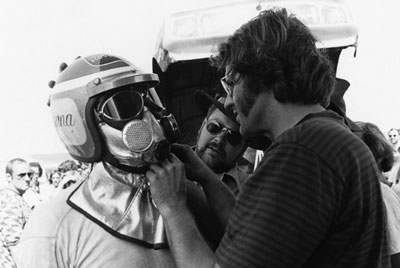
Al Hanna helped Shirl Greer into his borrowed equipment.
|
Of the four I interviewed, Hanna definitely had the best memory of the thrash and filled in some great details as well as offered others that I just couldn’t bring myself to put into print out of respect for those with squeamish stomachs.
Hanna told me a couple of things that I never knew, including that Prudhomme insisted to skeptical NHRA officials that they let Greer run the patched-together flopper in eliminations after all of the work that had been put into it. I also never knew that NHRA officials had insisted that Greer make a checkout launch with the car Sunday morning prior to eliminations before beating Leroy Chadderton in the first round. Anyway, I'm really pleased with the way it came together and humbly propose that it's likely the most definitive piece ever constructed about one of the most memorable pit thrashes in our sport's history.
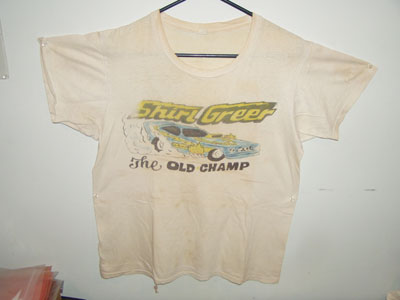 |
Longtime Insider reader Larry Peters also shared his Greer story, circa 1974. "A friend and myself went to U.S. 131 Dragway in Martin, Mich., for one of the usual Saturday night Funny Car match races, and while walking through the pit, we saw Shirl Greer unloading his car by himself," he wrote. "As we were watching, he asked if anybody had a pickup truck he could borrow for the evening. Apparently, his crew or helpers never showed up to the track. We said he could use ours. So we helped him that night, towing to the line and towing back from the top end. I even got the chance to help work on the car. It was a neat experience at the time. At the end of the night, he said all he had to give us was some beers and T-shirts. I still have that T-shirt [pictured], even though it's ready to fall apart. He was really nice, and it is sad to see he's gone. In 1996 at Indy, Bob Frey was doing the start of the NHRA Today show, and I was in the crowd as he walked by. They were taping the show, and I had this cool hat on, and as he walked by, he pointed at it. He then walked past several other people, and there stood Shirl Greer. I didn't know he was there until I got home that night and played the recorded tape back. Sure wish I had known he was standing there. It was the morning after Blaine Johnson died, and Steve Evans started the show. Hard to believe so many good people are gone now."
"As a professional drag racing photographer of note from the mid-1960s to early 1980s, Shirl Greer and I often found ourselves standing in the winner's circle on both sides of the camera lens," said Hall of Fame photographer Bob McClurg in a remembrance forwarded to me by Dave Wallace. "Shirl was a real gentleman and a class act. In the winter of 1975, after winning the much-publicized 1974 NHRA Winston Funny Car world championship, Shirl built an all-new Chained Lightning Mustang II Funny Car, which he debuted at the NHRA Winternationals, and he and I had made an appointment to photograph the car the week before the event for Kendall Oil and CARS Magazine. However, inclement weather prevented us from doing so, which meant photographing the car in the pits, which -- for many reasons -- would have been impossible. On the Saturday morning of the event, Shirl went to the NHRA and asked them if they would hold his spot in the pits while he loaded up the Funny Car on the back of that old Dodge Clinic transporter he used to have and drove around to the front of the L.A. Fairplex, where we photographed the car on the site where the Sheraton hotel now stands. Some might have called that preferential treatment, and in this day and age, that kind of request would have been absolutely impossible. But that just showed you the kind of respect that the newly crowned Funny Car champ had with the NHRA. I would also like to think that everyone involved that morning wanted to share in Shirl's good fortune and help him celebrate his onetime championship in any way that they possibly could."

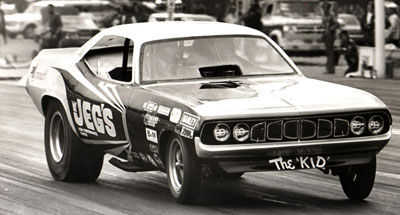 |
Reader Mark Whitmer, responding to the ongoing discussion about Jeg Coughlin Sr. and Funny Cars, reported that the late Bob Durban of central Ohio was the first to achieve a national event victory for the Coughlin family when he drove Coughlin's injected Hemi Barracuda to the Comp title at the 1972 Gatornationals, beating Tom Trisch in the final. "Bob D. was a friend and high school classmate," Whitmer added. "He and his cousins, Ned and Neil Durban, had some success racing gas dragsters in the East, and at one time, Neil, with the help of Bob Sinister, held the national record for C/Gas with his '41 Willys." I went to our files and dug out this shot of the car in question, showing "the Kid" in action.

Mickey Bryant, who with Todd Hutcheson is writing a book called Don Garlits, R.E.D., which focuses on the year and a half surrounding Garlits' debut of his first rear-engine car -- covering the period between Garlits' March 8, 1970, accident through Sept. 7, 1971, the last race of Swamp Rat 14 – took note of my musings about Arnie Behling's contribution toward the acceptance of the rear-engine Top Fuel idea with his 1971 Summernationals win. "Even though in our new book we highlight all of what Garlits did in 1971, we do point out others were doing quite well in other rear-engine cars," he wrote. "Ironically, on the same weekend of Behling's win, Carl Olson, in the brand-new Kuhl & Olson rear-engine car, posted a stout 6.52 on its very first pass at Lions. Coast to coast, they were after 'Big.' "
Olson confirmed Bryant's information and told me that Woody Gilmore at Race Car Engineering built the car, whose construction began immediately after the team returned from the 1971 NHRA Springnationals in Dallas with the front-engine car that today is seen in the Cacklefest.
"The Lions debut was just the initial shakedown run with no paint, chrome, etc.," Olson said. "We did not compete that night. We first ran the car in competition several weeks later at OCIR. Our first NHRA national event participation with that car was at the 1971 NHRA Nationals in Indy, where we ran very well and were awarded Best Appearing Car."
 |
I asked C.O. if there was a lot of opposition and naysayers about the switchover. "Quite to the contrary," he remembered. "I think most Top Fuel racers were convinced rear-engine was the way to go, but most were not in a position to make the change right away. Many had just ordered or taken delivery on new front-engine dragsters. There were a few front-engine 'hard cores' (John Wiebe and the Berry Brothers & Hughes come to mind), but most of our contemporaries were thinking rear-engine just as soon as time and resources would permit."

And, finally, in Tom Nagy's Fan Fotos from the Midwest, I mentioned the Bill Schifsky/Doc Halladay Cox Pinto. Kevin Cooley of Longmont, Colo., dropped me a line and these photos to show that the car is still around and running. It's now driven by Jon Reich and powered by an injected Chevy. Cooley captured the images at the Muscle Car Reunion at Kansas City Int'l Raceway last September. In the photo at right, you can see that the crew cleverly covers the injectors with a couple of the Cox toys when the car is in the pits.
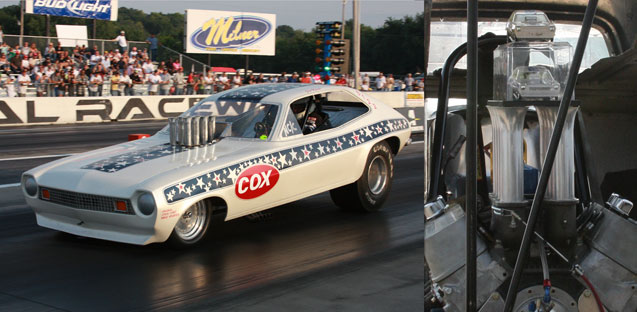 |



















































